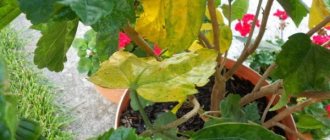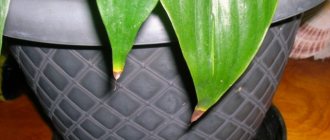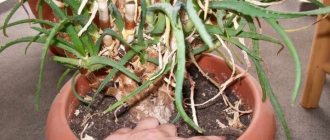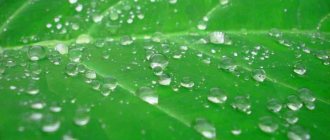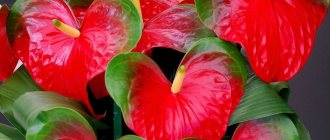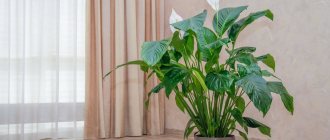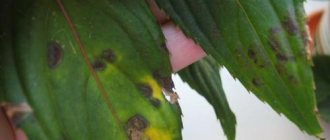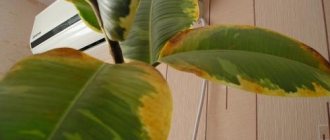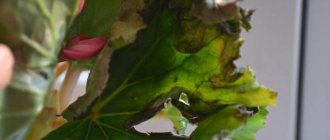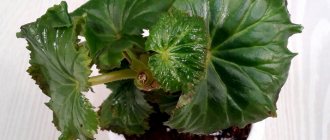The main pests of dracaena with photos
Pests, as well as fungal and bacterial diseases, affect dracaena due to improper care.
In addition, insect larvae may be on recently purchased flowers, and in the absence of quarantine they quickly spread throughout the collection. Dracaena is a favorite target of mealybugs, spider mites, aphids, thrips and scale insects.
Mealybug
It is easy to identify this pest - small cotton wool-like waxy secretions form on a plant infected with mealybugs. They can be found both on the leaves and at the growth point, causing developmental delays. This pest feeds on the juices of dracaena, and has “love” not only for the leaves, but also for the stems.
Mealybugs can be eliminated in several stages:
- Manually remove the pest from the bush using cotton wool soaked in soapy water or alcohol;
- Wash the dracaena in the shower, spray it with soap or soap-alcohol solution (1-2 g of laundry soap per 1 glass of vodka), also wipe the flowerpot and window sill;
- Treat the bush with a solution of an available insecticide (“Aktellik”, “Aktara” and their analogues);
- Transplant the dracaena into a new pot and fresh soil with mandatory preliminary disinfection.
Complete destruction of the mealybug in case of severe damage to the flower is possible only with the help of 2-3 treatments at intervals of 2 weeks.
Shchitovka
The size of the scale insect does not exceed 5 mm, while the insect itself is red in color and inactive. Since the pest has a shell, it is quite difficult to fight it, but it is possible. Dracaena affected by scale insects withers, its leaves lose their rich color, droop, dry out and fall off. When examining the underside of the plates, you can notice the characteristic whitish mucus.
The fight against scale insects involves manual collection using a sponge dipped in soapy water, as well as repeated spraying with insecticides (Decis, Fitoverm, Actellik, Intavir).
Thrips
Keeping dracaena in rooms with low air humidity at elevated temperatures is the main reason for the damage to this flower by thrips. Small insects (no more than 2 mm) settle on the underside of leaves, eventually forming numerous colonies.
Signs of thrips infestation are as follows:
- Light spots on the outside of the leaf that turn into brown spots over time;
- Grayish-brown tint of leaf blades, acquiring a characteristic silvery sheen;
- "clumping" of black dots on the underside of the leaf mass.
To completely get rid of thrips, it is recommended to spray dracaena several times with insecticide solutions (3-4 times depending on the degree of damage). The same drugs are used as in the fight against scale insects.
Spider mite
The spider mite is a yellow-green insect of rather small size (no more than 0.5 mm). The pest feeds on plant juices, significantly reducing its immunity to other diseases, slowing growth and development.
The mite settles on the underside of the leaf, which eventually becomes covered with small white spots. Upon closer examination, you can notice cobweb-like formations that cover the affected areas. As the pest spreads, the leaves randomly turn yellow and then darken.
Treatment of spider mites involves treating dracaena with a hot soapy solution (about +50 degrees). After drying, the bush is sprayed with the acaricide “Fitoverm”, “Akarin” or “Aktellik”.
Small insects settle in colonies on the tops of the shoots and the bottom of the plates, sucking the juices out of them and causing severe damage, twisting into a tube. Soon the affected leaves become discolored, turn yellow and fall off.
Aphids need to be controlled with insecticides, which are reapplied when the pest spreads heavily. The drugs Antitlin, Actellik, and Iskra show good results.
Timely treatment of dracaena significantly reduces the likelihood of flower death. After complete elimination of fungal diseases or pests, the plant requires careful care.
Pests
Why Dieffenbachia leaves turn yellow - reasons
Failure to follow the rules of care leads to parasites attacking the dracaena. Sucking the juices from the leaves leads to the slow death of the flower.
Pests can destroy a flower overnight
Dracaena pests:
- thrips. This is the most dangerous parasite that attacks indoor plants. Its length is only 1.5 mm. Pests, settling on the foliage from below, begin to actively suck out the cell sap. The females gnaw through the tissue, causing the leaf blade to turn yellow. As a result, the foliage dries out and falls off. High room temperature leads to their rapid reproduction. To save the flower, dracaena leaves are sprayed with a soap solution and covered with a plastic bag. A sticky trap also reduces the number of pests. In addition, drugs such as spark, fitoverm help;
- Mealybugs. This insect can be seen with the naked eye. On top it is covered with a white waxy coating. Females and larvae suck the juice from the cells, disrupting the development of the flower. Moving quickly, they leave behind a whitish coating. Using a toothbrush dipped in soapy water, you can remove waxy traces of parasites. Akhtar, fitoverm or calypso will help save dracaena in case of severe damage;
- scale insect A common parasite among indoor plants. This arachnid is covered on top with a protective shield. The female lays a huge number of larvae, which, like adults, are covered with scutes. They are securely attached to the foliage and suck the juice from it. Dracaena stops developing, turns yellow, dries out and dies. Treatment is carried out using a sponge and methyl alcohol (very carefully). Once weakened, the pests are destroyed with drugs such as Inta-SM or Actara. Yellow leaves of the plant must be removed.
Important! After treating the plant with chemicals, it is necessary to replace the top layer of the substrate.
Pests in flower pots
The appearance of pests in a flower pot is no less dangerous for dracaena than an infectious disease or improper care. Like most house flowers, dracaena leaves are susceptible to attacks by spider mites, scale insects, aphids and thrips. Given the small distance between flower pots in indoor conditions, pests are usually found on several neighboring plants and the means to combat them does not depend on the type of flower. Detected pests must be removed with a soapy sponge, and the entire plant must be treated with an insecticide (apply according to the instructions).
Finally. The publication discusses in detail the symptoms of possible dracaena diseases and methods of their treatment. The appearance of the leaves of this decorative flower can “tell” an attentive gardener about all its problems, so we recommend that you periodically conduct a thorough inspection of the plant. We hope that the theoretical knowledge gained after reading the article will be useful in organizing the care of your favorite flower.
Dracaena leaves are elongated with thin edging along the edges, which is why it is called fringed dracaena. The edging is most often reddish or yellowish. As the plant trunk grows, the lower leaves die and fall off. Due to this, the trunk is formed in the form of scales or scars. This plant is ideal for home and office.
It does not require special care. The optimal temperature for the growth and development of dracaena is +21°C. In winter, it needs moderate watering; under no circumstances should you overwater the soil. It is enough to water once a week, the main thing is not to let it dry out. In summer, on the contrary, the plant requires a large amount of moisture, and in the heat it requires regular spraying. The palm tree does not tolerate drafts, so when ventilating, the plant must be protected from cold air flows.
The tree needs to be transplanted into a larger container at least once every two to three years.
It must be replanted very carefully, trying not to damage the roots. It is better to purchase soil specifically designed for dracaenas.
The plant grows much better if the soil is periodically loosened.
Like any indoor plant, dracaena is subject to attacks from various pests and diseases. The homeland of this plant is the tropics, so often the causes of problems are conditions that differ from the warm and humid conditions they are accustomed to. We should not forget that flooding of dracaena in combination with low temperature in the room where the plant is located can lead to its death. However, other problems with this plant are often encountered - dry tips of the leaves. In addition, spots may appear on the leaves.
The appearance of dry ends can be caused by several reasons. The main one is too bright lighting in the room. Dracaena prefers diffused light. Only in this case will the foliage retain its rich, rich color. In dark, poorly lit rooms, bright artificial light should be turned on.
Low air humidity can also cause dry ends. However, the tree can only be sprayed during the warm season. In winter, it is better to use a humidifier.
The tips of the leaves can also become dry due to the tight container in which the dracaena grows. In this case, it is necessary to transfer the plant to a larger container, renewing the top layer of soil. Weeping brownish spots on palm leaves indicate sunburn; the plant does not tolerate direct sunlight.
Leaves can begin to dry if there is a large accumulation of dirt and dust on them. In case of heavy contamination, the leaves will have to be washed thoroughly under a warm shower; in case of light contamination, it is enough to wipe each leaf with a swab moistened with water.
Problems possible when growing dracaena
Why do dracaena leaves periodically turn yellow and dry?
The lifespan of dracaena leaves is no more than two years, then they begin to turn yellow and their tips dry out. But they die and fall off very slowly, so to preserve their decorative qualities, the dried part must be periodically trimmed.
If yellowing and falling of young leaves occurs, it means that the plant is not watered regularly. Also, if the dracaena turns yellow, this may indicate that the soil is overcooled.
Why do the tips of dracaena leaves turn yellow and dry?
As a rule, this occurs with low air humidity and insufficient watering. Also, the edges of the leaves can dry out in the presence of drafts and insufficient or, conversely, excessive fertilizing, as well as in the wrong selection of soil. It is necessary to reconsider the conditions of the plant, identify the cause and eliminate it.
If the tips of the leaves are wet at first and then dry out, this may be the cause of sunburn. The reason for the blackening and drying out of young foliage can also be that the plant has not been replanted for a long time (about three years). During this time, a large amount of salts accumulate in the soil, which prevents the plant from absorbing nutrients in the required quantities. An urgent replanting of the plant is required, as complete destruction of the root system is possible.
What to do if dracaena dries out
As a rule, dracaena withers and dries with insufficient watering or high dry air. This can also happen when the soil is overwatered; in this case, the roots rot and the dracaena dies. You can try rooting the top of the plant.
What to do if alocasia leaves turn yellow is written here.
Why do anthurium leaves turn black, and how to prevent it, read here: https://cvetolubam.ru/anturium-bolezni/
You can find out why vriesia does not bloom and how to get it to bloom in this article.
The dracaena leaves have drooped and become dull
The reason that dracaena drops its leaves may be drafts, direct sunlight, overwatering of soil, lack of spraying and improper selection of soil. You also need to check the root system, it may be rotten. It is necessary to eliminate the rot and replant the plant; if this is not possible, you need to root its top.
What to do and how to save dracaena if it is broken
As a rule, cats often drop dracaena when they eat its leaves. If the top of the plant is broken, then it can be placed in water so that it takes root or immediately rooted in the substrate, while it must be covered with polyethylene, and ventilated and watered every day as necessary.
The stump remaining in the pot can be treated with activated carbon or cinnamon. Over time it will produce new side shoots.
If the dracaena has a soft trunk
If the dracaena's trunk has become soft, you need to remove it from the container and inspect the roots; most likely, they have rotted due to excessive overwatering.
You need to either trim the root system to a healthy state, or if it is completely dead, cut off the healthy part of the plant and root it again. It is better to do this in a dark glass or plastic container with water; roots form well in it.
Since dracaena is susceptible to many diseases that are difficult to treat, it is necessary to regularly carry out preventive examinations, which will identify the disease at its initial stage and preserve the plant.
The leaves are turning yellow
Before taking any action to save your home palm tree, you need to figure out why the dracaena leaves began to turn yellow.
If the leaves of the dracaena turn yellow in large quantities and in a short time, then the plant is either frozen or dry. In the first case, the salvation will be to “move” to a warmer room and spray with warm water (the optimal temperature is from 18 to 22 °C). In the second - abundant but careful watering.
The main reason that leaves turn yellow and fall off is due to improper watering. Because of this, the roots of the dracaena rot and the nutrition of the flower as a whole is disrupted.
There are other reasons:
- Excessive watering and stagnation of water in the pot (although this plant loves a lot of moisture, you should wait until the soil dries out before watering again). You can save dracaena in case of too much watering only by timely operational actions: you need to get it out of the ground, clean and dry the root system, and remove rotten roots.
- Watering occurs in cold soil.
- Insufficient watering.
- Excessive spraying (you need to make sure that the leaves at the base remain dry and water does not stagnate there; if you overdo it, you need to take a short break from such care).
Yellowing of dracaena leaves can also occur due to the fault of parasitic insects. It could be:
- spider mite (its presence is indicated by fairly noticeable yellow spider fibers);
- scale insects (these are very small brown insects that look like fleas);
- mealybug (when this parasite settles on a flower, small lumps appear on the leaves, similar to small pieces of cotton wool);
- thrips (its colonies look like white spots on the foliage).
In the event of the appearance of any of these parasites on dracaena, the scheme of action is the same. You must first thoroughly wash the plant with a soapy solution and alcohol, covering the soil tightly with polyethylene so that soap and insects do not get on it, and then treat it with special insecticides.
If the leaf blades turn yellow and fall off en masse, it is worth remembering the last time the soil in the pot was changed. Salts accumulate in old soil, which block the flow of nutrients to the roots. The flower is probably lacking nutrients and needs to be fed.
It is better to place the pot away from open windows in a darker room or 1 m from the window (it is worth remembering that variegated foliage requires more diffused soft light than plain color).
Dracaena leaves turn yellow and fall off: what could be the reasons?
Dracaena gives any interior an exotic look. It is also called palm or false palm. Yellowing of leaves can be caused by a number of reasons. There are cases when even the most experienced gardeners cannot understand why dracaena leaves turn yellow and how to help it. And sometimes even if you take proper care, it is not enough.
Various reasons lead to yellowing of foliage
The most common reasons for the appearance of yellow leaves in dracaena:
- natural aging. The lower leaves of the flower turn yellow and die, and this is a normal process. If the stem is tall and elongated, the main trunk should be cut off to allow new stems to grow and tillering to increase;
- excess moisture. Too much moisture is another cause of yellowing leaves. Waterlogged soil and lack of drainage provoke root rot, which leads to weakened immunity and the development of diseases, the symptoms of which can be determined by the condition of the leaves. By watering once a week, you can improve the condition and color of the leaves;
- lack of humidity. This factor also affects the condition of the flower and causes the dracaena to appear yellow leaves. Tropical plants grow well in conditions of high humidity; dry air in city apartments is contraindicated for them. The plant should be regularly sprayed and moistened, especially in winter, when the air in homes is too dry. You can place containers filled with water next to the pot to increase the humidity in the room;
- direct sunlight. They are harmful to the leaves as they cause them to turn yellow. It is important to choose the right place where the flower will stand. Dracaena should always be protected from the sun;
- lack of light. In low light, the plant turns yellow, starting from the lower leaves, then the leaves fall off. Sometimes the leaf blade turns yellow when one side is in the shade. Therefore, the flower should be rotated periodically to ensure even exposure to light;
- viral infection. If the plant is infected with a virus, the first symptom will be yellow foliage. The leaf blade and stem are also deformed. The infection is contagious, so it can spread to neighboring indoor flowers;
- pests Spider mites, thrips, and scale cause yellowing of the leaves and the appearance of additional symptoms, such as brown spots on the stems, grayish plaques on the leaves, or thin whitish marks. Pests suck out the cell sap, so the leaves turn yellow and fall off.
Finding out why the leaves began to turn yellow is not so difficult. You should analyze the care of the flower and correct errors.
Note! Yellowing of the lower leaves is a normal natural phenomenon for a houseplant. In order for new foliage to appear, the flower needs to get rid of the old one. But if yellowing occurs en masse, this most often indicates the development of the disease.
Why clerodendrum does not bloom: plant diseases and pests
Most often, changes in growth, development, and abundance of flowering can be observed in cases of improper care of this plant. To solve the problem, you should identify the error in growing the flower and eliminate it. For example, the reason that the leaves of clerodendrum begin to turn yellow, and sometimes the plant may begin to shed them, will be insufficient watering, keeping it in a room that is too dry, or prolonged exposure of the foliage to direct sunlight.
Flower growers note that the plant is quite resistant to diseases. Most often, spots of chlorosis can be observed on the leaves of this vine. For clerodendrum, the appearance of such a disease signals a deficiency of iron in the soil. To stop such destructive processes, the foliage is treated with preparations containing this element (iron chelate). For a plant with signs of chlorosis, such treatment should be carried out three times a year.
Unlike diseases, harmful insects are a real problem when growing clerodendrum. The most common pests that can be found on it are:
- Spider mite.
- Aphid.
- Whitefly.
Spider mites appear in the internodes of the plant and look like a spider's web. In this case, you can observe the wilted state of the foliage. To combat these insects, chemicals should be used (Akarin, Talstar, Vitoverm, Vertimek). The plant should be sprayed once, unless the instructions say otherwise, and another treatment should be carried out after 14 days.
Aphids are a pest that causes clerodendrum to not bloom or produce deformed buds at home. Flower growers can immediately determine its presence on the plant. Typically, aphids live in groups and concentrate on the leaves, at the base of the flower. It feeds on plant sap and is a carrier of viral diseases. When it appears on the clerodendrum, cut off the damaged elements and treat the flower with chemicals (“Aktara”, “Commander”, “Korado”).
The whitefly looks like a midge, which is clearly visible even from a distance. It lays its larvae at the base of the leaves, and its life processes lead to the fact that the greenery of the plant is covered with a white coating. If clerodendrum is infected with whitefly, you need to remove all affected areas and spray the flower with fungicides.
Why do dracaena leaves dry out: reasons
The main factors that provoke shedding of leaves in dracaena:
- greenery renewal;
- microclimate disturbance;
- excess or deficiency of moisture and fertilizers;
- incorrectly selected place for growing;
- damage by diseases and pests.
On average, a dracaena leaf blade lives and develops for 2 years. When the greenery is renewed, the tips of the lower leaves turn yellow and dry out.
If the leaves do not fall off on their own, you need to carefully disconnect them from the main stem. If improperly cared for, yellowing begins at the top of the plant.
In this case, the most important thing is to quickly find the cause and eliminate it.
Disturbed microclimate
When growing dracaena, you should take into account the fact that this plant is tropical, and the indoor microclimate should be as close as possible to natural.
The main factors that negatively affect the development of greenery:
- reduction of air humidity to 50–60%;
- temperature below +18 ℃;
- temperature regime is above +27 ℃.
As humidity decreases, the apical leaves lose their density, turn yellow and die. When the temperature drops, the foliage becomes covered with dark spots and curls. At elevated temperatures, the leaves fall along the trunk.
Improper fertilization and watering
Excess or lack of nutrients equally negatively affects plant development. The leafy part may develop poorly and wither due to lack of nitrogen. With its deficiency, the leaves change shape, acquire a lighter shade and fall off. An excess of this element, combined with abundant watering, leads to an increase in soil pH and rotting of the root system.
Often the cause of yellowing is improper water procedures. Dracaena needs to be showered periodically or generously sprayed with water. But after this, be sure to drain the sinuses of the leaf plates. The accumulation of water in the axils leads to rotting, so the foliage turns yellow and dies. Lack of moisture leads to a weakening of the root system, which is externally manifested by shedding of greenery.
Wrong choice of growing location
The tropical plant prefers abundant diffused light. Prolonged exposure to direct sunlight leads to burns on the leaves. Dracaenas do not develop well on southern windowsills and near heating devices that dry out the air.
Pests and diseases
Even if you follow all the rules of care, it is quite difficult to protect yourself from pest attacks and the spread of fungal diseases. Fungal spores and insect larvae can be transmitted from a diseased plant to a healthy one or spread during transplantation if the soil mixture has not been properly treated.
Among fungal diseases, dracaena most often develops:
- brown spot or Alternaria blight;
- leaf spot;
- dry spotting.
Among the pests that can settle on dracaena leaves when grown at home:
- scale insect;
- thrips;
- aphid;
- mealybug;
- spider mite
Brown spot
The main symptom of Alternaria blight is oval light brown spots located over the entire surface of the leaf. In the central part of the spots there are clearly defined circles of a darker color. After some time, the leaves become covered with a dark coating consisting of fungal spores, which interferes with the normal process of photosynthesis.
Leaf spot
When there is an excess of moisture, irregularly shaped spots of a darker shade than the leaf plate appear on the leaves. Sometimes fluid may be seen in the central part. The disease develops when there is an excess of moisture.
Dry spotting
The disease affects leaf blades on both sides. The drying process begins with the apical leaves. First, yellow spots appear, which over time acquire a darker shade and, when dry, form holes.
Other Possible Problems
Other prerequisites for drying leaves include:
- Insufficient pot volume - active growth of the root system and an increase in plant size requires timely replanting. The procedure is carried out with the utmost care, trying to avoid damage to the roots. Sometimes the process can cause a palm tree to spontaneously shed its leaves due to stress.
- Direct exposure to the sun - from the sun's rays, the foliage begins to dry out and change its usual shade to a yellowish color. In some cases, a dried stem folds in half and may dry out and die.
- Draft - the window sill is not suitable for the plant due to possible drafts and temperature changes under the influence of central heating. When ventilated, the culture will quickly begin to hurt.
- Fertilizing - insufficient or excessive application of fertilizers leads to yellowing and falling leaves.
Burns on leaves
There is no point in treating the affected leaves - experienced gardeners advise cutting them off to avoid general infection of the green part. If recommendations are ignored and inaction is prolonged, it is impossible to save a sick palm tree.
Dracaena is a beautiful crop that enriches homes with oxygen and decorates the room. Compliance with maintenance rules will help to avoid many problems, including the development of diseases and attacks by insect pests.
What to do if the trunk also dries out?
Many people wonder why the leaves of dracaena dry out, but no one notices that the trunk itself can dry out along with them. If you cut such a trunk, most likely you will see a terrible picture - empty space, like a straw. These are signs of plant rot, which are indicators that you have not properly cared for your dracaena. Sooner or later, such a stem will simply fall, and the life of the plant will come to a real end.
Rot spreads from the root system upward. She eats the plant from the inside. The danger of this phenomenon lies in the fact that it becomes noticeable even when the flower is practically dead, since the appearance, with the exception of the dracaena leaves, almost does not change.
If the situation is not yet too large-scale, then the dracaena can be revived. In this case, you should reduce watering, pay more attention to drafts and under no circumstances allow hypothermia. To preserve the dracaena, it must be moved to a dry and warm place.
Another equally interesting option is to transplant the plant into a new substrate. This must be done very carefully, since at any moment the stem may break and not withstand the load. As a container for planting dracaena, you need to take a clay pot. This is a natural and environmentally friendly material that allows oxygen to reach the root system in the required quantity. This allows her to breathe, and the trunk will not be able to continue to die. A special drainage should be installed in the new pot; without it, it is almost impossible to restore the dracaena.
When replanting, it is imperative to pay attention to the condition of the shoots. If they are also affected by rot, then it is better to cut them off, otherwise the trunk will not recover at all or this process will last a very long time
If you perform all the above operations, the dracaena can be restored. Moreover, after treatment, it will sprout new shoots that will look more attractive and fresher than the old ones.
As you can see, there are a lot of answers to the question why dracaena dropped its leaves. This plant does not seem to be whimsical, but sometimes it is still demanding. If you properly care for your dracaena, you will not have such problems at all.
Air temperature
There is an answer to the question why dracaena hung its leaves and what to do in this case. The reason may be dry, hot air.
Regulating the air temperature will correct the situation. Then the plant will be able to raise its leaves.
- In summer and spring, Dracaena feels comfortable at temperatures from +20 °C to +25 °C. If the air is even warmer, the crown will lose its beautiful appearance.
- In winter, it is permissible to keep the flower at a temperature from +17 °C to +19 °C. The temperature should not be allowed to drop below +15 °C.
Sudden temperature changes are also dangerous. If the flower begins to shed its leaves, it means it has suffered from hypothermia.
Dracaena and its care
This exotic flower has long been loved by many. It will always decorate any room with its appearance. Dracaena belongs to the Dracaena family. It is also called false palm.
This evergreen shrub or tree grows naturally in the tropics and subtropics of Africa, less commonly on the islands of southeast Asia. In total, there are more than 100 species of plants, but only 40 species are grown in greenhouses and no more than ten at home.
Its beautiful green leaves add zest to the interior of the room. There are some types of dracaena that do not resemble traditional dracaena in appearance. Almost all dracaenas growing at home are not very demanding in terms of care.
If you care for it properly, there shouldn't be any problems. With careful and competent care, the plant can live at home for up to 15 years. Sometimes the plant may bloom, for example, downy dracaena.
Experts recommend paying special attention to watering and temperature for the normal development of indoor plants. Dracaena feels good if there is no temperature difference in the room
On average it should be 18−25 °C. The leaves suffer from sudden changes and drafts, their edges begin to freeze and then dry out.
Dracaena: tips of leaves dry out, what to do
Many flower lovers ask this question, because almost everyone who has dracaena faces this problem. We will try to consider the most common reasons why the tips of dracaena leaves dry out.
- Watering. This is also one of the main reasons. There is not enough moisture, watering is irregular or scarce. As the lump of earth in the pot dries out, the dracaena needs to be watered. Even in winter, the flower is watered at least once a week.
- Drafts. The plant immediately reacts negatively to cold air and drafts in the room. It should not be placed on a windowsill during the cold season, nor should it be kept close to the air flow from the air conditioner. From the cold air, the soil begins to lose a lot of moisture, the leaves of the flower react painfully to this.
- The soil. It affects the appearance of the palm tree, so it should be selected correctly. Over time, watering and hard water cause the composition of the soil to deteriorate. Compacted soil does not allow the root system to develop and, as a result, the leaves dry out and fall off. The problem can be solved by transplanting the flower into a new soil mixture, which is fresher and more nutritious.
- Lighting. Dracaena loves light, but without direct sunlight. She needs diffused lighting in a well-lit place. From the bright sun, burns in the form of spots appear on the leaves, then they dry out.
- Diseases. Infectious diseases are transmitted through the soil from other diseased flowers. Diseases are also transmitted when flowers are located too close.
Air humidity. The flower belongs to the tropical species, so it needs to create favorable conditions with a comfortable level of humidity. It is believed that a suitable humidity level for dracaenas should be in the range of 60−70%.
There is no such level of humidity in our apartments for various reasons - heating, summer heat. It is necessary to increase the humidity by spraying the flower with warm water from a spray bottle, and use air humidifiers.
Why do the leaves turn yellow?
Dracaena leaves live for about two years. The old leaf mass begins to turn yellow from the tip.
If this happens, the leaves must be removed. It often happens that the leaves of a young plant begin to turn yellow for unknown reasons.
Experts say that yellowness appears for several reasons:
- improper care;
- improper watering;
- insufficient nutrients;
- pests
The appearance of yellowness is provoked by excessive watering of the plant. In summer, it is recommended to water the flower 1-2 times a week. At high temperatures, it is advisable to place the flower in the bathroom more often and spray it.
This procedure has a very positive effect on the leaf mass and refreshes it. After bathing, no moisture should remain in the axils of the leaves. For this reason, leaves often begin to turn yellow.
The plant responds very well to fertilizing with a high nitrogen content. Liquid fertilizer with nitrogen can be added to the water for irrigation so that the dracaena receives all the necessary substances during the period of intensive growth.
This phase occurs from March to August. Fertilizing is sold in a flower shop and you must buy it, since a lack of nitrogen will cause yellowness to appear on the leaves.
Root rotting
The palm tree begins to die if the following conditions are present:
- Excessive watering - accumulation of liquid in pots leads to a lack of oxygen. The root system is left without the necessary nutrients. The result of overflow is softening of the trunk and blackening of the foliage.
- Cold and drafts - constant temperatures below +15 ℃ provoke fading of the leaves, over time they turn black and fall off.
Root rot
Important! If the ends of the leaves dry out, it is necessary to change the care of the dracaena at home: reduce the frequency of watering and move the flower box to a room heated to +20 ℃. Resuscitation measures for a frozen palm tree begin with a warm shower, which can be done by lowering the pot into the bath, covering the soil with plastic wrap and dousing the green part with water (not higher than +40 ℃).
Problems during cultivation
Errors in growing dracaena cause certain troubles, which are manifested by plant ailments:
- The leaves are turning yellow.
The reasons why the ends of the leaves begin to dry: natural wilting or improper watering.
Natural wilting is a natural process caused by plant growth. Each dracaena leaf lives for about two years and one day the time comes for it to die. Therefore, the lower leaves of the plant may turn yellow.
First the top turns yellow, and then the entire leaf dries out. This wilting occurs slowly, so the dried part can be removed gradually, thus preserving the decorative appearance of the plant.
Yellowing of young leaves occurs when watering is disturbed. Both dry soil and too wet soil are harmful to dracaena. Moderate humidity with a dried top layer is an ideal watering option.
- The leaves faded and drooped.
Reason: hypothermia.
Dracaena does not tolerate temperatures below 14 degrees Celsius, as well as drafts and cold air currents. If you place the plant in a warm place and spray it with warm water, it may come to life.
Hypothermia can also lead to root rot. In this case, the plant needs to be replanted by removing the rotten roots.
- The tips of the leaves dry out.
Causes of dry leaves: dry air, lack or excess of fertilizing.
If dry tips appear on the plant or spots along the edge of the leaf, care must be taken to create more comfortable conditions. To preserve the decorative appearance, the shrunken ends are cut off.
- The leaves fall and the young shoots of the dracaena dry out.
The reasons why the plant sheds its leaves: hypothermia of the earth, excess moisture in the soil.
If leaves fall in large quantities, it is recommended to cut the plant.
- Brown spots on leaves.
Cause: burn caused by direct sunlight.
When a burn occurs, wet spots first appear, which then dry out.
To avoid this, dracaena should receive gentle sunlight.
- The leaves rot.
Causes: waterlogging, lack of light and heat, or an infectious disease.
If a yellow border forms around the spot, then this is bacteriosis.
If there is no border, then the reason lies in insufficient care.
To avoid rotting, you need to reconsider the conditions of the plant.
- Blackening of young leaves.
Reasons: lack of replanting for a long period or oversaturation with fertilizers.
Dracaena needs to be replanted every 2-3 years. If the dracaena is not replanted on time, salts accumulate in the soil, which leads to damage to the young leaves.
If this is not the reason, then you need to limit the amount of fertilizing applied.
And here is a video about why dracaena leaves dry out.
Diseases
Why do the tips of leaves on indoor plants dry out?
Dracaena leaves dry out in the presence of specific diseases:
- Alternaria blight - pale brownish spots with a whitish center form on the foliage. The affected areas darken and die over time.
- Bacteriosis - the ends of the foliage become brownish, then the lesion takes over the healthy parts. The stem, trunk and petioles are covered with pitting with an oily border.
- Heterosporiasis - spots of a beige hue with a reddish edging form on the leaves. Further development of the pathology leads to a change in the color of the marks to a greenish-gray tone.
- Powdery mildew - initially lighter areas appear on the foliage, which darken and turn brown over time.
- Gray rot - manifests itself as light brown spots, which over time become covered with a whitish coating with fluff. The second symptom of the disease is blackish dots on the leaf blades.
- Phyllosticosis - dark brown spots with blackish inclusions appear on leaf blades. The disease is more often observed in mature plants.
- Fusarium - leaves turn yellow from the tips and become watery at the edges. As it spreads, the upper part of the trunk begins to dry out, the stems darken and become thinner, and the entire plant becomes covered with dark brown spots.
Important! When affected by spotted wilt, the foliage is covered with yellowish-brown streaks that turn bronze when exposed to ultraviolet light. Plant growth stops, young leaves are small, with a non-standard shape. Over time, the culture dries out and dies.
Manifestation of phyllosticosis
Soil moisture
The domestic palm tree is quite demanding in terms of soil moisture. It needs to be watered at least 2-3 times a week. Overwatering can harm the palm tree. The consequence of excess moisture in the soil is rotting of the roots. If black dots appear on the leaves at the bottom of the stem of the chamedorea, this is a clear sign of waterlogging in the soil. In winter, it is recommended to water the plant no more than once a week.
Bamboo Palm Care
Palm trees love high humidity. If the leaves begin to dry out and darken, then it’s time to take action. Spraying the foliage and air with a spray bottle will help solve the problem. You need to do it every morning. Then each leaf should be wiped with a napkin. This procedure will allow the leaves to breathe and also help get rid of accumulated dust and dirt.
Note! If there is no possibility of daily spraying, then it is recommended to place a container with water and pebbles near the flower pot.
Preventing the problem from recurring
To avoid such problems in the future when growing a succulent, you need to remember the following basic recommendations:
- The optimal regime for feeding the plant is once a month from March to September. In winter, you should refrain from feeding succulents.
- It is better to plant the plant in a purchased substrate, which is marked “For cacti and succulents” or “Universal”. To the latter you need to add coarse river sand.
- When feeding zamioculcas, be sure to study the instructions for the fertilizer being applied and strictly adhere to the recommendations given in it.
- The ideal location for the succulent is a stand or bedside table next to the southeast, southwest window. When bright sunlight hits the greenery in the summer, it is advisable to shade the window with a curtain or special foil film.
- Proper and regular watering is the key to successful plant growth. Be sure to ensure that water does not stagnate in the pan after moistening.
Yellowing of the leaves and drying of the stems of zamioculcas are most often the result of improper care. Another common reason is pests and diseases. There is no need to rush to get rid of the plant: sometimes the simplest solutions can solve the problem.

